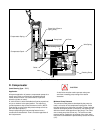
14
Section V – Service and Maintenance
A. Service Tools
The following standard tools for overhauling the piston pump
are shown in Figure 8.
Standard Tools and Equipment:
1. Torque wrench with short extension and sockets
2. 1” micrometer
3. 1” depth micrometer
4. External Truarc pliers
5. Internal Truarc pliers
In addition to the above tools, an arbor press is required to
service bearings, etc. Maintenance of this unit is intricate
and should not be attempted without the proper tools.
Special Tools:
Special tools are shown in Figures 9, 10, 11 and 12.
B. Inspection
Periodic inspection of the fluid condition and tube or piping
connections can save time consuming breakdowns and
unnecessary parts replacement. The following should be
checked regularly:
1. All hydraulic connections must be kept tight. A loose
connection in a pressure line will permit the fluid to leak out.
If the fluid level becomes so low as to uncover the inlet pipe
opening in the reservoir, extensive damage to the pump can
result. In suction or return lines, loose connections permit air
to be drawn into the system resulting in noisy and/or erratic
operation.
2. Clean fluid is the best insurance for long service life.
Therefore, the reservoir should be checked periodically for dirt
or other contaminants. If the fluid becomes contaminated the
system should be drained and the reservoir cleaned before
new fluid is added.
3. Filter elements also should be checked and replaced
periodically. A clogged filter element results in a higher pres-
sure drop. This can force particles through the filter which
would ordinarily be trapped or can cause the by-pass to
open, resulting in a partial or complete loss of filtration.
4. Air bubbles in the reservoir can ruin the pump and
other components. If bubbles are seen, locate the source of
the air and seal the leak. (See Table 3).
5. A pump which is running excessively hot or noisy is a
potential failure. Should a pump become noisy or
overheated,the machine should be shut down immediately
and the cause of improper operation corrected.
C. Adding Fluid to the System
When hydraulic fluid is added to replenish the system, it
should always be poured through a 10 micron (absolute) or
better filter.
It is important that the fluid be clean and free of any
substance which could cause improper operation or wear of
the pump or other hydraulic units. Therefore, the use of cloth
to strain the fluid should be avoided to prevent lint from
getting into the system.
D. Adjustments
No periodic adjustments are required, other than to maintain
proper shaft alignment with the driving medium.
E. Lubrication
Internal lubrication is provided by the fluid in the system.
Lubrication of the shaft couplings should be as specified by
their manufacturers. Coat shaft splines with a dry lubricant
(Molycoat or equivalent) to prevent wear.
F. Replacement Parts
Reliable operation throughout the specified operating range
is assured only if genuine manufacturer’s parts are used.
Sophisticated design processes and materials are used in
the manufacture of these parts. Substitutions may result in
early failure. Part numbers are shown in the parts service
drawings listed in Table 2.


















